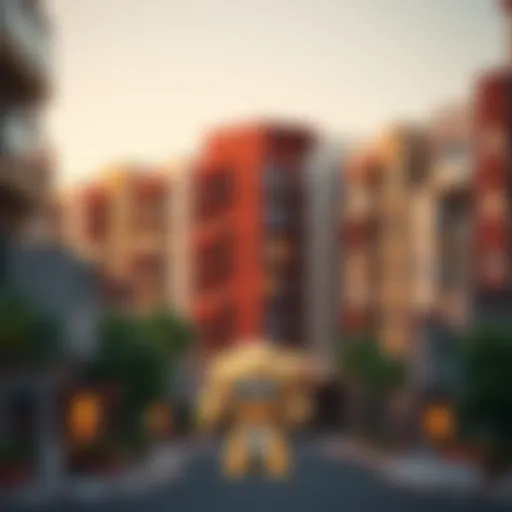The Impact of Interior Design on Dubai's Real Estate


Intro
Dubai's booming real estate market has become a playground for investors and homebuyers alike. With its glittering skyline and diverse communities, the emirate draws people from all corners of the globe. However, there's more beneath that shiny surface. The role of interior design companies in this vibrant landscape is not merely decorative; it's foundational to boosting property values, enhancing livability, and aligning with the unique cultural fabric of the city.
Interior design firms are not just about aesthetics; they're pivotal in shaping the experiences of residents and the perceptions of investors. As the real estate sector becomes more competitive, these companies must navigate a landscape influenced by trends and economic factors.
By understanding the intricacies of what interior design brings to the table, stakeholders—from developers to end-users—can make informed decisions. This article will peel back the layers, exploring the intricacies of how interior designers are intertwined with Dubai's real estate trajectory.
Market Insights
The intersection of interior design and real estate in Dubai presents an evolving narrative.
Current Trends in Dubai Real Estate
Today's dynamic real estate market is marked by several striking trends:
- Sustainability is becoming a non-negotiable aspect, with eco-friendly designs gaining traction among buyers.
- The push for smart home technology has led to the incorporation of innovative solutions that enhance conveniences.
- Mixed-use developments are increasingly popular, blending residential, commercial, and leisure sectors to create more vibrant living spaces.
As these trends develop, interior design companies play a crucial part in translating them into actionable designs that resonate with potential buyers. They adapt their offerings to ensure that properties not only sell but also create a lasting impression on future residents.
Economic Factors Impacting Property Values
Diving deeper, factors such as market stability and foreign investment trends significantly influence property valuations. The fluctuating real estate prices in Dubai mean that a well-designed interior can make a difference in attracting buyers.
- The overall economy of the UAE has a direct correlation with purchasing behavior in the real estate sector.
- Fluctuating oil prices can affect investor confidence, leading to a varied demand for premium properties versus budget options.
"Interior design is not just about creating appealing spaces; it is key to driving real estate value in a competitive market."
As the market adapts to these challenges, innovative interior design companies must remain ahead of the curve, ensuring they tailor their designs to meet the evolving demands of both investors and residents.
Investment Guides
For investors and first-time buyers in Dubai, understanding property investment within this context is essential.
Tips for First-Time Buyers
- Research Thoroughly: Familiarize yourself with different neighborhoods to understand where your investment will thrive.
- Consider Design Needs: Look for properties that offer flexibility in design, making them easier to adapt as market preferences shift.
- Engage Professionals: Working with experienced interior designers can illuminate possibilities that enhance property value.
Portfolio Diversification Strategies
Investors should consider various strategies to mitigate risk:
- Invest in different property types, such as residential, commercial, and hospitality.
- Incorporate properties that appeal to varying demographics, ensuring a broader market reach.
For more on the strategies and insights from the real estate sector in Dubai, you can explore further on platforms like Britannica or community discussions on Reddit.
Ultimately, this journey through the intricate relationship of interior design and real estate in Dubai shows how crucial these firms are—not just as mere decorators, but as key players in a competitive market.
Preface to Interior Design Companies in Dubai
The world of interior design is not just about aesthetics; it plays a crucial role in shaping environments that are functional and inviting. In Dubai, where towering skyscrapers and affluent lifestyles dominate the landscape, interior design companies serve as the architects of experiences within these spaces. They are key players in the real estate market, and their influence can be seen in residential buildings as well as commercial spaces. These companies are not merely decorators; they thread together design principles and cultural nuances to create environments that resonate with Dubai's diverse population. In an increasingly competitive market, understanding the impact of these companies is paramount for investors, developers, and homeowners alike.
Defining Interior Design
Interior design involves more than just arranging furniture or selecting color palettes; it is about creating spaces that enhance the quality of life and culture of the occupants. Each project begins with understanding the client's vision, which then informs the selection of materials, space planning, and the integration of technology. In Dubai, where the mix of cultures is as rich as the city’s history, interior design must often cater to various tastes and expectations, from opulent luxury to modern minimalism. A firm's ability to navigate these diverse preferences is critical in ensuring client satisfaction and ultimately, success in the market.
The Role of Interior Design Companies
Interior design companies in Dubai hold a pivotal position in the construction and real estate development process. They facilitate the translation of architectural concepts into functional living and working spaces. Here are several key roles they play:
- Enhancing Property Value: Quality interior design significantly contributes to the overall valuation of properties, making them more appealing to potential buyers and renters.
- Reflecting Brand Identity: For commercial spaces, interior design embodies the brand's identity, helping businesses communicate their values and mission to customers.
- Creating Functional Spaces: Beyond visual appeal, these companies optimize layouts to ensure efficient use of space. This is especially crucial in Dubai, where residential space is often at a premium.
- Sustainability: Many interior design firms are now focusing on sustainable practices, using eco-friendly materials and energy-efficient solutions to meet the growing demand for environmentally responsible design.
"In a city that prides itself on innovation, interior design is not just an art form; it is a strategic tool shaping the essence of living and working spaces."
In summary, the contribution of interior design companies in Dubai is multifaceted, impacting various sectors of the real estate market. Their expertise allows for the metamorphosis of spaces, elevating experiences for residents and contributing to the vibrancy of Dubai’s real estate landscape.
Market Overview
Understanding the market overview is crucial in grasping how interior design companies fit into the broader picture of Dubai's real estate sector. This segment highlights significant market dynamics and explores pertinent trends that influence property value and investment decisions. As investors, developers, and buyers navigate this bustling landscape, a well-informed perspective on current market conditions can make all the difference in strategic planning and decision-making.
Current Trends in Dubai's Real Estate
The real estate market in Dubai has been undergoing a notable transformation over the last few years. Increased demand for luxury living spaces has burgeoned, propelled by a growing expatriate population and affluent investors seeking a prime location. A few stand-out trends include:
- High Demand for Sustainability: More homeowners and renters are gravitating toward environmentally-friendly designs that minimize carbon footprints. Innovations have led to the development of energy-efficient buildings flaunting smart home technologies.
- Focus on Multifunctional Spaces: As remote work becomes commonplace, there’s a heightened emphasis on spaces that blend work and leisure seamlessly. Buyers are now looking for designs that can adapt to both personal and professional needs.
- Luxury Market Resurgence: Wealthy expatriates have returned to Dubai, spurring high demand for upscale properties. Interior design plays a crucial role in upgrading these properties to cater to affluent tastes and lifestyles.
These trends not only shape the interior design landscape but also establish benchmarks for market expectations, driving competition among design firms to deliver cutting-edge solutions.
Impact of Interior Design on Property Market Value
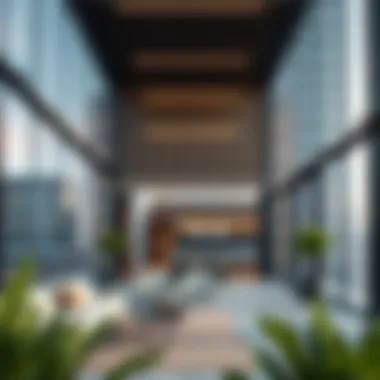
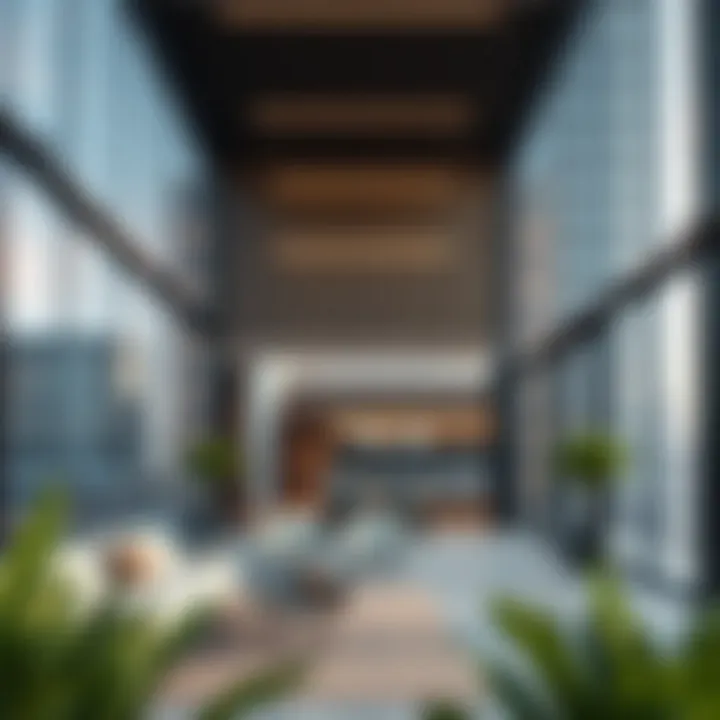
It’s often said that the first impression is everything, and in the realm of real estate, interior design significantly enhances a property's perceived value. Here are some ways in which this impact unfolds:
- Aesthetic Appeal: Well-designed interiors capture the eye and spark interest, leading to quicker sales at higher price points. Quality finishes and thoughtful layouts can elevate a property above others on the market.
- Functional Spaces: Smart design can maximize usable square footage, a significant selling point in Dubai’s competitive market. A beautifully executed design can transform otherwise ordinary areas into appealing, functional spaces.
- Branding and Market Positioning: For developers, aligning with top-tier interior design firms can enhance brand prestige, lending an edge in a saturated market. Properties known for high-end design are perceived as more valuable, thus justifying higher price tags.
Services Offered by Interior Design Companies
Interior design companies in Dubai play a pivotal role in the real estate market, and understanding the services they offer gives insight into their contributions. These companies bring design expertise that enhances property appeal, increases market competitiveness, and meets the specific needs of the local populace. By doing so, they not only shape the interiors of homes and commercial spaces but also influence investment decisions, making their services invaluable.
Residential Interior Design
Residential interior design is about creating spaces that reflect personal style and functionality. Here, we explore two vital aspects: customization to client needs, and the balance between functionality and aesthetics.
Customization to Client Needs
Customization is at the heart of residential interior design. Each client has unique requirements, and meeting these needs is crucial to successful design. When clients approach a design firm, they often come with visions, preferences, and specific functionalities they desire in their home. This tailored approach ensures that each project is distinctive, thus resonating with the homeowner.
A key characteristic of customization is its personal touch. This makes it a sought-after choice for many clients. Homeowners often value designs that reflect their personalities, preferences, and lifestyles, turning their living spaces into a true sanctuary.
One unique feature of this customization aspect is the extensive use of mood boards and samples during the design process. This allows clients to visualize potential outcomes and compare different elements effectively. However, a notable challenge is that highly personalized designs may take longer to finalize, as numerous revisions might be necessary to align with the client's vision.
Functionality and Aesthetics
Finding the sweet spot between functionality and aesthetics is critical in residential design. This dual focus contributes significantly to the usability of a space while ensuring it remains appealing. Clients today are not merely looking for pretty interiors but also for spaces that facilitate daily living.
The character of this balance is its practicality without sacrificing beauty. Many homeowners appreciate designs that promote ease of movement and accessibility, coupled with a striking visual presence. This approach is particularly beneficial as it enhances the living experience.
A distinct feature of combining functionality with aesthetics is the selection of multi-purpose furniture. For example, a sofa that doubles as a bed or a coffee table with storage not only saves space but also adds style. However, the downside can sometimes lie in the cost, as high-quality, stylish multifunctional pieces may require a larger budget.
Commercial Interior Design
The commercial segment encompasses workspaces and public areas, emphasizing two essential components: optimization of space and brand representation.
Optimization of Space
In commercial interiors, space optimization is paramount. Businesses operate under constraints, so designing environments that maximize available space while facilitating productivity is essential. Interior design firms are tasked with creating fluid layouts that not only provide a sense of openness but also ensure that every square foot is utilized effectively.
Optimizing space often involves clever placement of furniture, utilizing vertical storage, and designing flexible working zones. This aspect becomes increasingly important in Dubai's growing real estate market, where space comes at a premium.
A unique feature of optimization is the open-plan office layouts that have gained popularity in recent years. These designs encourage collaboration and communication among employees. However, the challenge remains in striking the balance—ensuring enough privacy and quiet areas for focused work might sometimes be compromised.
Brand Representation
Brand representation in commercial interiors can significantly impact customer perception. The interior design must convey the identity and values of a brand. This helps in creating an inviting atmosphere that resonates with clients and customers.
A distinct characteristic of this approach is the alignment of color schemes, materials, and layouts with brand ethos. For instance, a tech company's sleek, modern office design reflects innovation, while a luxury brand's retail space may lean towards opulence and comfort. This becomes a powerful tool for marketing, influencing consumer behavior effectively.
The challenge is to maintain consistency across all touchpoints, especially if multiple locations exist. Divergence in design can create confusion about the brand message, potentially leading to a loss of identity in the marketplace.
Sustainable Design Practices
Sustainable design practices have become increasingly vital in interior design, reflecting a growing consciousness about environmental impact. These practices aim to create spaces that are not only beautiful but also eco-friendly, ensuring a healthier environment for occupants and minimizing the carbon footprint.
Companies are adopting materials sourced from renewable resources, low-VOC paints, and energy-efficient lighting. Emphasizing health and wellness in spaces has led to the inclusion of biophilic elements, which connect occupants with nature. This trend is gaining traction among consumers, influencing their preferences and decisions.
While sustainable designs often appeal to an environmentally aware audience, they may also come at a premium initially. However, the long-term savings and benefits frequently outweigh these costs, making it a worthwhile investment for many.
Choosing the Right Interior Design Company
Choosing the right interior design company is a crucial step for anyone looking to enhance their property in Dubai's dynamic real estate landscape. Unlike a simple paint job or rearranging furniture, interior design involves a well-thought-out strategy that incorporates both design aesthetics and functionality. The decisions made here can have long-lasting impacts, not only on the look and feel of the space but also on its market value and overall investment potential.
When looking for an interior design company, there are several elements to consider that can help guide your decision. These factors include the firm's reputation, previous work, the range of services they offer, and how well they understand client needs. A well-chosen design firm can ensure a process that aligns with your vision, results in a seamless experience, and most importantly, helps maximize the return on your investment.
Furthermore, it’s important to understand that not all interior design companies are created equal; their specialization can vary widely. For example, some firms may excel in residential designs while others focus primarily on commercial projects. Therefore, selecting a firm that matches your specific requirements will significantly influence the outcome.
"The interior space should be a reflection of your identity; choosing the right designer ensures that reflection is clear and compelling."
Understanding your own preferences as well as the market trends can significantly impact the selection process. Investing time in finding a company that aligns with current trends in Dubai's property market, such as sustainable practices and smart home technology, can set your property apart and yield higher value.
Assessing Portfolio and Style
A vital part of evaluating potential interior design companies is assessing their portfolio and style. Reviewing a designer's past work allows you to gauge whether their vision aligns with your own. Each designer has a distinctive style—some lean towards minimalism, while others embrace color and ornate styling.
When reviewing portfolios, consider the following:
- Diversity of Projects: Look for a range of designs that showcase flexibility and creativity.
- Previous Clients and Projects: It can be telling if the designers have worked with notable clients or projects that have gained recognition in the region.
- Attention to Detail: Look closely at how well the designer has executed their ideas, from the choice of materials to the harmonious use of colors.
- Functional Layouts: Beyond aesthetics, assess if the layouts promote functionality and usability. Are the spaces designed to live comfortably in, or do they just look good?
Understanding their aesthetic and how it meshes with your vision should be a priority in this process. After all, a snazzy design is no good if it doesn't serve its purpose.
Understanding Client Testimonials
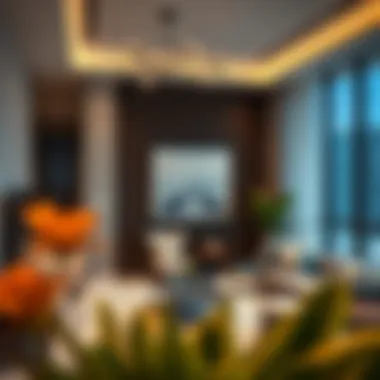
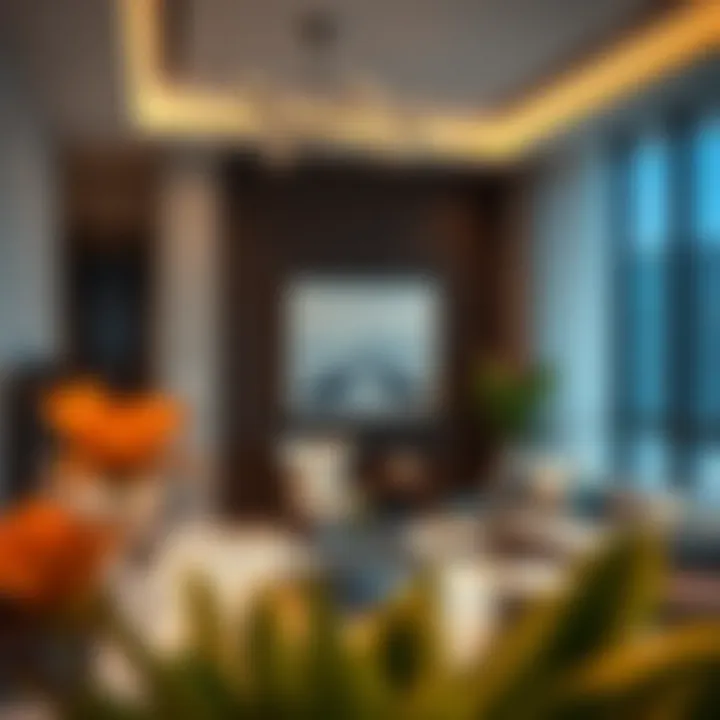
Client testimonials play a key role in providing insight into the interior design company's effectiveness and reliability. Reviews offer a candid view of previous clients' experiences, not only regarding the final result but also during the design process itself.
Consider the following aspects when relevant testimonials are evaluated:
- Reliability and Communication: Clients often mention how responsive and communicative a design firm is throughout the project. This is crucial for managing expectations and avoiding surprises.
- Satisfaction with Final Outcome: Are the clients happy with the end result? Look for comments specifically discussing how well the designs turned out compared to initial concepts.
- Adherence to Budgets and Timelines: Clients frequently appreciate firms that respect budgets and complete projects in a timely manner. Delays or excess costs can sour what should be a joyous process.
By paying attention to these testimonials, you can glean significant insights into which company may be the right fit for your interior design needs in Dubai's ever-evolving market.
The Design Process
The design process serves as the backbone of any successful project in the interior design realm, especially in a bustling city like Dubai. It is a structured sequence of phases that not only aids in curating spaces but also aligns the vision of clients with the creative capabilities of design firms. Navigating through this process ensures that the final design is not just an attractive visual but also a strategically planned space that meets functional needs. Below, we’ll break down the essential aspects of this vital process:
Initial Consultation and Briefing
Every project kicks off with an initial consultation, a critical step where the client communicates their vision, preferences, and requirements. This meeting is often loaded with rich discussions, as clients share their dreams while designers ask probing questions to clarify intentions.
During this stage:
- Designers gather information regarding the spatial environment.
- They assess the budget constraints and timeline to set clear expectations.
- They explore the client’s aesthetic inclinations, often by reviewing images, themes, or experiences that inspire them.
This preliminary dialogue ensures that everyone is on the same page, creating a roadmap that informs the subsequent stages. A well-conducted initial consultation reduces the risk of misunderstandings later down the line.
Concept Development
Once the initial ideas are on the table, the next phase is concept development. Here, designers transform the verbal insights obtained during the consultation into visual representations, showcasing their creative potential.
At this stage:
- Mood boards become essential tools, compiling colors, materials, textures, and potential layouts.
- Sketches or digital renderings provide an initial glimpse into how spaces may feel and interact with each other.
- Designers often present several concepts, allowing clients to choose elements they resonate with, fostering collaboration.
This phase is crucial because it encapsulates creativity while also keeping practicality in check. Designers must foresee how functionality mixes with aesthetics to ensure that spaces not only look great but also work well for everyday use.
Implementation and Project Management
Once the concept is approved, the project moves into the implementation phase, where visions transitioned to reality. This is where all the groundwork laid in the earlier phases begins to materialize. Effective project management becomes essential as it integrates all moving pieces.
Some important actions during this phase include:
- Coordinating with various contractors and suppliers, aligning everyone towards a common goal.
- Managing timelines and ensuring tasks adhere to the schedule, which is critical in minimizing delays.
- Regular site visits to oversee progress and tackle any emerging challenges promptly.
Good project management not only streamlines the execution of the design but also ensures adherence to quality standards, handling any unexpected hurdles that may arise. In a fast-paced market like Dubai, timely implementation can significantly impact client satisfaction and project success.
"An effective design process is about turning ideas into spaces that inspire and function seamlessly in harmony."
Challenges in the Interior Design Sector
The interior design sector in Dubai faces a myriad of challenges that can significantly impact the effectiveness and appeal of the services provided. Understanding these challenges is crucial for stakeholders looking to thrive in this competitive market. Interior design companies are not only tasked with creative vision but also with aligning their unique design philosophy with client expectations and market demands. As the city of Dubai continues to grow and evolve, these challenges create both obstacles and opportunities for interior decorators and designers alike.
Meeting Client Expectations
In a place like Dubai, where diversity is the order of the day, meeting client expectations can often feel like walking a tightrope. Clients come from various cultural backgrounds and possess different tastes. Therefore, delivering designs that resonate with each individual while remaining true to the aesthetic values of the space is a delicate balancing act.
Communication is key here. It’s not uncommon to encounter situations where clients have a different vision in mind. Interior designers must actively listen and interpret their clients’ desires correctly. This could involve anything from understanding subtle lifestyle nuances to interpreting vague inspirations shared by the client. Some may simply say 'I want something modern,' but that covers a spectrum from minimalist to lavish.
Furthermore, designers need to manage expectations regarding functionality versus style. Some clients might have grand visions of aesthetics but not consider how the design will serve their daily needs. Herein lies another challenge; creating a space that is not only visually pleasing but also practical. This means repeatedly checking in with the client, ensuring constant alignment throughout the design process, and making necessary adjustments—often under tight timelines.
For example, a client might envision an open-concept layout without realizing the structural limitations of their property. Identifying these limitations early can make or break the project.
Navigating Budget Constraints
When you get down to brass tacks, navigating budget constraints is another tangled web that interior design companies must master. In a high-stakes market like Dubai, budgets can often be fluid, with expectations varying widely among clients. While some clients may have a generous budget in mind, others may hope for high-end results without a corresponding investment.
Designers are faced with the challenge of delivering quality work within these financial parameters, all while ensuring client satisfaction. This can involve resourceful sourcing of materials and negotiating with suppliers to stay within budget without compromising on quality. Smart designers often find a happy medium; they are adept at suggesting cost-effective alternatives that still fulfill the overall vision.
It’s also important for them to maintain transparency about costs throughout the project. Shockingly high expenses can lead to dissatisfaction and result in broken trust. Having a clear financial outline from the get-go can alleviate potential conflicts down the road.
"In the world of design, sometimes less really is more. A good designer knows how to stretch a dirham without cutting corners."
Some interior design companies have even adopted a tiered approach to budgeting, offering different packages that outline varying levels of service. This allows potential clients to choose an option that best aligns with their financial situation while giving designers a framework to deliver within constraints.
Influence of Technology on Interior Design
The integration of technology into interior design is not just a trend—it's a revolution reshaping the landscape of this creative industry. In Dubai's competitive real estate market, where each property vies for attention, utilizing modern technological tools becomes essential. These innovations not only enhance the effectiveness of design strategies but also significantly optimize client interactions and project outcomes.
The role technology plays in interior design goes hand in hand with the demands of an ever-evolving market. Designers and architects are increasingly prompted to adapt and adopt these advancements in order to stay relevant and deliver remarkable spaces that appeal to discerning buyers and investors.
Utilizing Design Software and Tools
Today's interior designers wield powerful software that can transform visions into detailed plans. Programs like AutoCAD and SketchUp allow designers to create intricate 3D models, laying the groundwork for projects that are visually compelling and technically sound. These tools enable a level of customization and precision that was previously unimaginable.
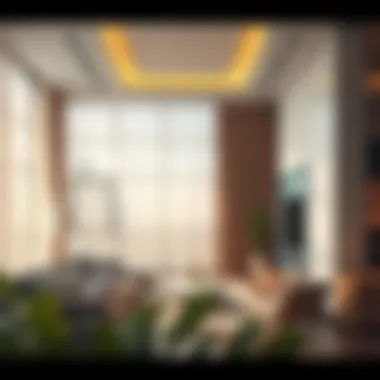
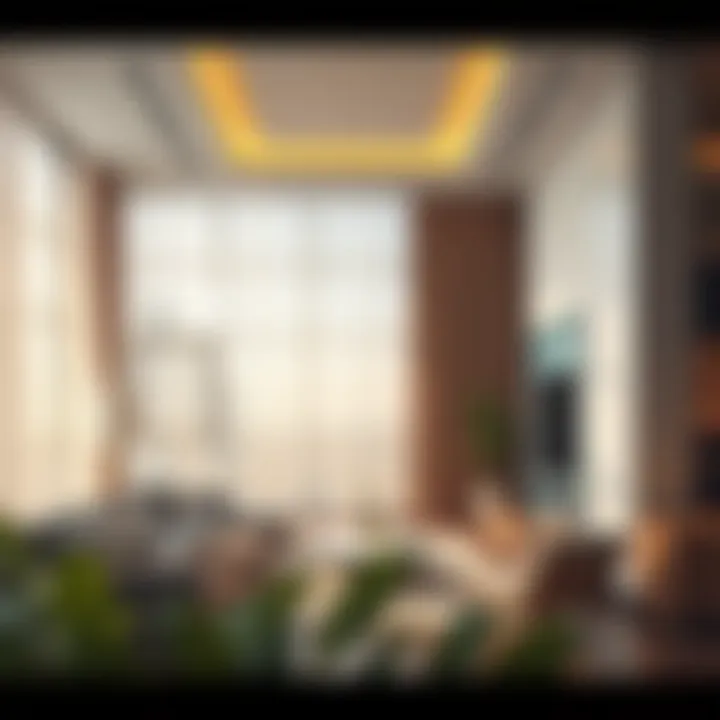
- Efficiency: Software enhances productivity, ensuring that modifications can be quickly implemented without starting from scratch.
- Collaboration: Cloud-based platforms enable multiple stakeholders—designers, clients, contractors—to access and contribute to projects in real-time.
- Visualization: Clients can see a realistic representation of their future spaces before any physical work begins, alleviating concerns and aligning expectations.
As a result, the design process has shifted from simple sketches to comprehensive digital formulations, fostering a collaborative atmosphere that allows for greater creativity and problem-solving.
Virtual Reality in Design Presentations
Virtual reality (VR) is taking the design world by storm, particularly in a city as futuristic as Dubai. With VR, designers can present immersive experiences that take clients beyond traditional presentations. Imagine walking through a fully furnished living room or exploring a commercial space before construction even begins.
- Immersive Experience: Clients can navigate through their spaces, spotting potential issues or providing feedback in real time.
- Enhanced Engagement: By providing a 360-degree view of projects, clients are more likely to connect with and understand their designs, leading to more effective decision-making.
- Reduced Miscommunication: VR minimizes the chances of misunderstandings between designers and clients, ensuring everyone is on the same page.
"Virtual reality is not merely about designing a space; it's about creating an experience that resonates with clients on a personal level."
Case Studies of Successful Projects
In the intricate world of Dubai’s real estate, the impact and significance of interior design companies cannot be overstated. Case studies of successful projects not only showcase the design capabilities of these firms but also serve as a practical guide for potential investors, agents, and developers. They present tangible examples of how thoughtful design can elevate property value and enhance marketability.
Residential Projects
Residential projects demonstrate how interior design can transform a house into a home, yielding substantial returns on investment. For instance, consider the Dream Oasis Villa, a high-end property located in the exclusive Jumeirah district. The designers opted for a blend of contemporary and traditional Arabic elements, emphasizing warm tones and intricate patterns that reflect the local culture. This choice not only catered to the aesthetic preferences of potential buyers but also increased the villa’s value by nearly 20% within two years post-renovation.
- Key Elements:
- Use of natural materials like marble and wood to create an inviting atmosphere.
- Incorporation of smart home technologies, enhancing functionality and modern living.
In the competitive market of luxury residences, homeowners seek personalized touches that resonate with their lifestyle. A notable example is the Ocean View Apartment. Here, the interior designers focused on maximizing natural light and views, creating an open plan that flows into expansive balconies. This design approach not only maximized the interior space but also highlighted the stunning skyline views, adding a premium to the property.
"An inviting and well-designed space can significantly impact the emotional connection buyers feel towards a property."
Commercial Projects
When discussing commercial projects, the role of interior design assumes another layer of importance. These spaces need to reflect the brand's identity while remaining practical and efficient for business operations. One case worth mentioning is the Innovative Workspace, a tech start-up hub in Dubai Media City.
- Design Strategies:
- Flexible workspace arrangements to support collaborative endeavors among employees.
- Use of vibrant colors that encourage creativity and innovation while maintaining professionalism.
The incorporation of break-out areas with comfortable seating and inspirational decor has led to a marked increase in employee satisfaction and productivity, traits crucial for fast-paced industries.
Similarly, the Green Pines Restaurant in Downtown Dubai utilized interior design to create a unique dining experience. By integrating elements of nature, such as vertical gardens and earthy textures, the designers crafted a welcoming environment that became a local favorite. This thoughtful design approach not only attracted customers but also enhanced the value of the establishment, positioning it as a leader in the competitive culinary scene.
In summary, these case studies exemplify the indispensable role of interior design in both residential and commercial projects within Dubai’s dynamic real estate market. The intersection of aesthetics, functionality, and market dynamics underscores the value that professional design firms bring to the table.
The Future of Interior Design in Dubai
The realm of interior design in Dubai is poised to undergo significant transformations as the market continues to evolve. Given Dubai's position as a global hub for business, tourism, and luxury, the future of interior design here will undoubtedly reflect broader trends in consumer preferences and technological advancements. Understanding these dynamics is crucial for anyone involved in the real estate sector—be it investors, developers, or local homebuyers. They must grasp how shifting demands and innovative design practices will shape property values and market viability in the years to come.
Evolving Consumer Preferences
As we look to the future, it is essential to recognize that consumers these days are becoming more discerning. Gone are the days when a simple aesthetic appeal was enough to clinch a sale. Now, individuals are increasingly looking for designs that resonate with their personal values and lifestyles. Factors such as sustainability, wellness, and smart home technology are becoming buzzwords that influence design preferences.
Homebuyers, particularly millennials and Gen Z, prioritize eco-friendly materials and energy-efficient solutions. They are leaning towards maximizing space in their apartments and homes, favoring multifunctionality over opulence. This is not just a trend; it’s a voice from a generation that values experiences over excess.
For real estate investors, understanding these preferences can significantly impact decision-making when selecting properties for redevelopment or enhancement. Ultimately, the aim is to capture the essence of what modern living means in Dubai—a blend of style, functionality, and sustainability.
Emerging Designers and Trends
The future of interior design in Dubai is also marked by the emergence of innovative designers who are pushing the envelope in creativity. New collaborative partnerships between local design firms and international talents are paving the way for a unique blend of styles that encapsulate both local culture and global trends. This cross-pollination of ideas is critical in attracting investors looking for distinctive projects that stand out in the marketplace.
Moreover, there’s a rising interest in minimalism, characterized by clean lines and uncluttered spaces. This is coupled with the growing appreciation for cultural narratives that tell stories through design, leading to a diverse range of expressions in residential and commercial spaces. Designers are now focusing on tailor-made solutions that reflect the individuality of their clients while also considering long-term functionality and maintenance.
Ultimately, the interplay between consumer needs and these forward-thinking designers will help mold the next chapter of interior design in the city. Future interiors will not only be about walls and furnishings but about crafting environments that enhance quality of life and resonate on a personal level.
"The future will see designers tapping into local heritage, while also staying ahead of international trends, creating spaces that are both timeless and modern."
Investors and developers attentive to these shifts will be better positioned to make informed decisions, ensuring their projects are competitively attractive and relevant. Keeping an ear to the ground regarding emerging trends and preferences will be key to succeeding in Dubai's ever-dynamic real estate landscape.
Finale
In the bustling marketplace of Dubai's real estate, the role of interior design companies extends far beyond mere aesthetics. These businesses form the backbone of a property’s charm and market appeal. As examined throughout this article, they not only elevate a property's value but are also pivotal in shaping buyer experiences and perceptions. Their influence adeptly navigates through evolving consumer preferences, aligning beautifully with architectural trends while integrating modern technology.
Summarizing Key Insights
- Interior design firms are crucial in boosting property market values. Sophisticated designs combined with functional layouts are key to attracting buyers.
- The partnership between real estate and interior design fosters innovation and sustainability, reflecting the city’s commitment to a progressive future.
- The continuous evolution of consumer tastes necessitates a deep understanding of the market, enabling design companies to stay ahead of the curve. Leaving no stone unturned, they adapt their strategies to meet the desires of both residential and commercial clientele.
By dusting off the surface of what interior designers genuinely contribute, it’s clear they play a vital role in the enhancement of Dubai's real estate appeal.
Implications for Real Estate Investment
The insights gleaned from the explorative analysis here reveal crucial implications for real estate investors. Understanding that interior design directly impacts marketability underscores the importance of strategic partnerships. A well-designed property not only captivates potential buyers but also increases resale values, making initial investments more lucrative.
Investors should recognize the necessity of engaging reputable design firms to tailor their spaces. This engagement goes beyond simple decor; it ensures functionality, aesthetic appeal, and aligns with local trends and consumer expectations. This thoughtful approach to investment can ultimately translate into higher returns.
"Investing in quality interior design is akin to laying down the cornerstone of a prosperous future in real estate."
In summary, the implications are clear: to thrive in Dubai's competitive real estate market, understanding and incorporating quality interior design practices is not just beneficial; it's essential.



